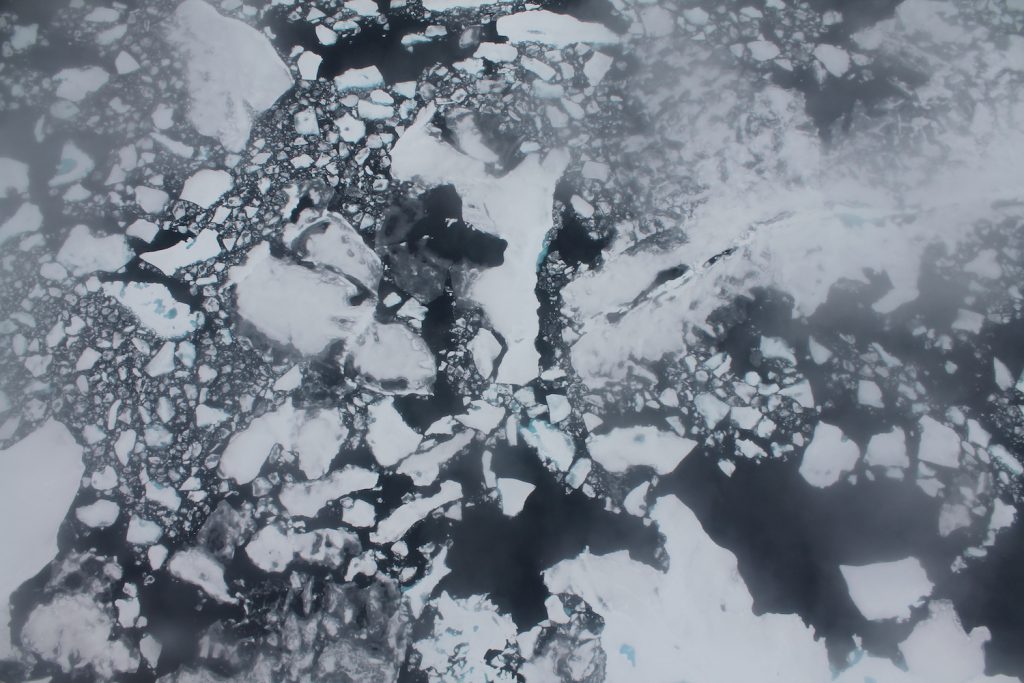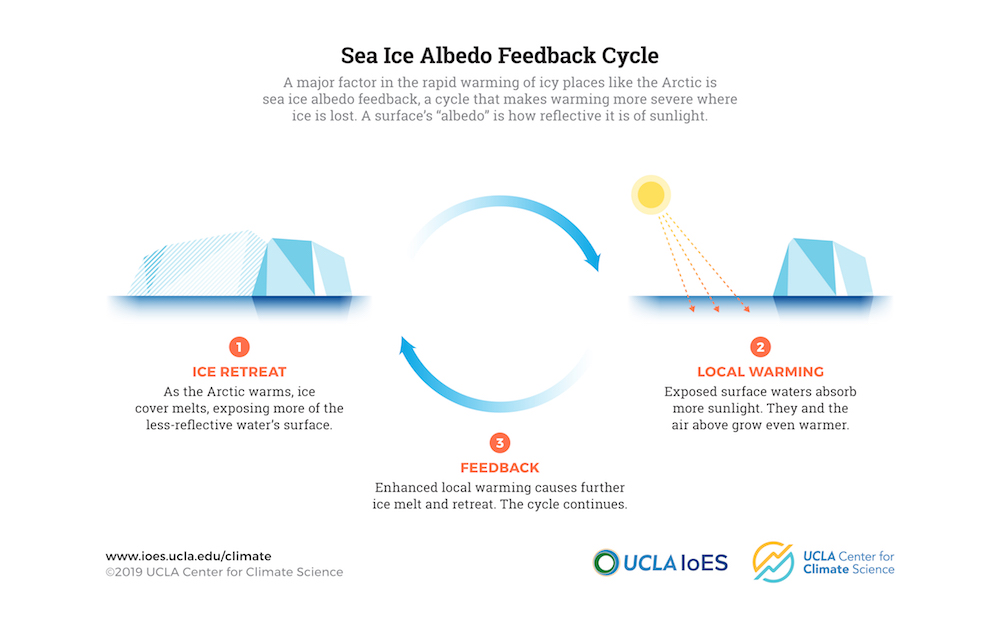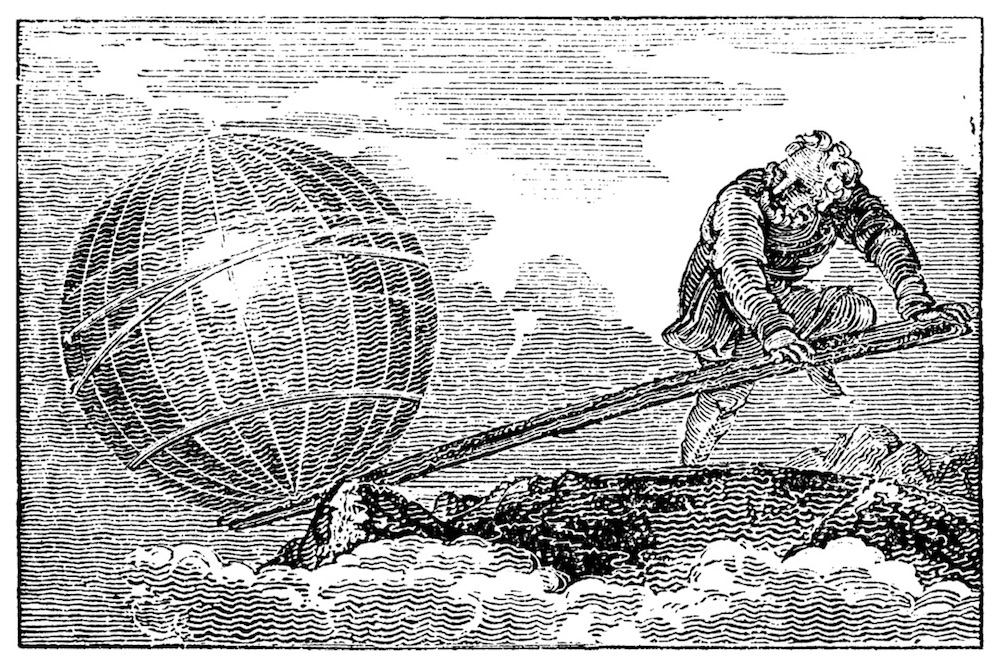Partnering With Nonhumans for Climate Action

Arctic sea ice is dying: Its extent, volume, and thickness have all dropped over the past 40 years due to global warming. And as the ice melts, researchers and companies ramp up their case for geoengineering: using technology to deliberately alter both the ice and the climate of the Earth.
Taking action on anthropogenic climate change is urgent and necessary. But turning to technology as a means of asserting human control over the environment is unhelpful, if not counterproductive.
There are several proposals out there for how to save Arctic ice. One involves an iceberg-making submarine that would chill seawater to its freezing point and spit out hexagons of ice. Another involves a fleet of wind-driven mechanical pumps that would splash seawater on top of ice to thicken it from the top. The Arctic Ice Project (AIP; formerly Ice911 Research), which I find particularly intriguing, is a privately funded nonprofit from Silicon Valley that aims to spread hollow, buoyant glass microspheres over portions of the ice to make it more reflective, bounce away sunlight, and cool the surface.
There is something in the AIP’s official presentations that particularly caught my eye: The organization says it plans to use Arctic sea ice as a “lever” to affect global climate.
At the heart of this notion is the Western idea that humans are separate from nature rather than an integral part of it. The image of a “lever” assumes that humans are controlling something apart from themselves—something sitting on the other end of the lever. This philosophical division between humanity and the rest of the planet has long been used to justify some cultures’ treatment of resources, such as fossil fuels and minerals, as expendable, controllable, and exploitable in service to a humanity that stands outside of the environmental damage being done. This view of humans as exceptional beings, separate from nature, is what got us into today’s environmental crisis in the first place.
Theoretically, AIP’s proposal makes sense. Sea ice does play an important role in the global climate system: It reflects sunlight, which lowers temperatures, creating more ice, which lowers temperatures further, making more ice, and so on.
But there are huge risks to this plan that may lead to unintended environmental consequences. And for me, as an anthropologist working on sea ice and climate change, the larger issue is the unhelpful assumption that humanity—standing apart from nature and asserting its will on the planet through technology—is the most important agent in climate change.
Technological options will likely play a role in taking action on climate change. But how we conceive, design, and use technologies has the potential to reinforce problematic human-environment relations, or to invite new ones. We need to move away from treating technology as a “lever” that grants humans power and control over a passive, separate nature. As raging wildfires, collapsing ice sheets, and invasive species suggest, humans are not the only or most powerful agents in the world.
Instead, we need to approach nonhumans as potential partners in action.
Reading about how the AIP started is revealing. “The aha moment for me,” said AIP founder Leslie Field in an interview with the press, “was framing [the climate change problem] in a way I could address.”
“I don’t know how to negotiate international agreements, I haven’t a clue,” continued Field, who was trained as a chemical and electrical engineer. “But in terms of technology, I wondered: ‘What if some safe material could replace the lost functionality of that great reflective ice that’s gone?’ When I started phrasing it like that, it wasn’t exactly a piece of cake, but it became an addressable challenge I could take on.”
Climate change is a notoriously thorny problem. To quote anthropologist Adam Fleischmann: “The causes and effects of climate change are long-lasting and distant from one another. It is everywhere and nowhere at once, made up of global, long-term trends that play out locally in mostly imperceptible ways.” The sheer scale and complexity of a problem as monstrous as climate change can leave individuals feeling hopeless and helpless. This feeling is exacerbated by the lack of political will to date by many national and international bodies to take serious action on climate change. Technology can help restore a sense of agency to individual humans.
Greek polymath Archimedes is often quoted as having said, “Give me a place to stand, and with a lever, I will move the whole world.” This can be interpreted as praise of the engineering utility of levers in particular or of technology in the abstract. Technology is a mover of worlds. For the AIP, technology is a lever that grants power to individual specialists on international stages and global reach to a small organization. It grants human technologists, both today and in the past, the impression of power and control over a system as vast and complex as the global climate system.
Focusing on levers can lead people into a technical trap, however, whereby a complex problem is falsely reframed as a simpler, technical one just to make it tractable. As extensive scholarship has shown, this kind of thinking has led to plenty of negative unintended consequences and avoidable problems. In worst-case scenarios, an unending chain of problems seems to be the primary outcome of “solutions” to problems narrowly defined as technical ones.
If we are going to take climate change and the many challenges it poses seriously, we need to rethink our assumptions.
Take, for example, the use of DDT to control insects that damage crops and spread disease. As environmental scientist and writer Rachel Carson famously reported in her book Silent Spring, DDT had wide effects on living beings beyond insects, entering the food chain and probably causing cancer. Other insecticides have proven problematic too, as insects have evolved resistance to them, making insect control even harder. Technological solutions to insect control are today being advanced in the form of genetic technologies, like releasing genetically modified mosquitoes that can’t successfully reproduce. Some analysts have cautioned against such plans because they could lead to yet more problems.
In the case of sea ice, several scientists have already expressed skepticism about the scientific and economic feasibility of the AIP, and wonder if it will only make the problem worse in unanticipated ways (by altering weather patterns, for example) or divert funding away from other needed measures. Iñupiaq community members in Alaska have also raised concerns about adding glass microspheres to sensitive Arctic ecosystems, a lack of local community involvement in preliminary research, and the project’s potential impacts on local hunting, fishing, and trapping.
As feminist and Indigenous scholars have repeatedly argued, if we are going to take climate change and the many challenges it poses seriously, we need to rethink our assumptions. Other ways of imagining the world are possible.
What if, for example, sea ice was instead imagined as a partner? Partnership does not necessarily imply perfect equality but acknowledges and respects the agency of another.
This way of thinking has proven useful already. Take, for instance, the human relationship with microbes. Bacteria were once considered mainly as a threat to human well-being, resulting in technological warfare through antibiotics. This saved many lives but also gave rise to antimicrobial resistance—a new and grave problem for human society. A different way of envisioning the microbial world acknowledges it as a partner: The microbiome, for example, which describes the diverse microbes living within and on the human body, is now understood as a vital and integral part of human health and humanity.
I reached out to AIP’s Principal Engineer Alexander Sholtz to learn more about the organization’s work. Sholtz emphasized that their work is at the research stage, with many questions as-yet unanswered. I asked him if the AIP might consider treating sea ice as a partner.
“I think that’s a great way of putting it,” Sholtz said. “We haven’t phrased it like that ourselves, but … without sea ice, there’s no way that this particular material [glass microspheres] is going to grow back [ice] from nothing. I think thinking about it as a partner is correct.”
The AIP’s proposed official modus operandi, however, is to use sea ice as a lever of control over the climate system, rather than to work with ice as an agent in its own right.
When it comes to taking action on climate change, I encourage the AIP and other geoengineering initiatives to think about human-environment relations as their starting point rather than as a side effect of technology and innovation. This may help broaden options beyond developing technological solutions to, for instance, applying one’s scientific background to science-based policymaking.
And when it does come to developing technological interventions, keeping human-environment relations in mind can transform the design, testing, and implementation of technology. Instead of being a strictly technical task, technology design becomes an exercise in partnership building among humans and nonhumans within a shared environment.
Climate change is a complex problem of a global scale; any attempt to alter its trajectory requires collective, concerted, and sustained collaboration—not just among human actors such as scientists, technologists, anthropologists, policymakers, artists, and business leaders, but also among nonhuman actors like ice. Going it alone is not a viable approach.



































